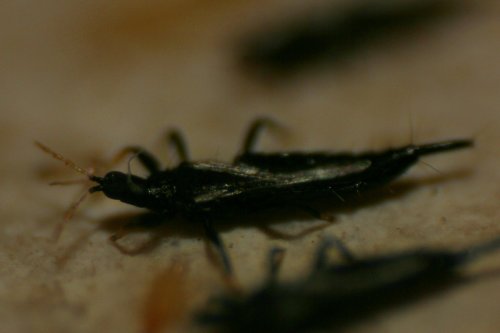jbrough42
New Member
My girlfirend and I just spent and hour and a half tediously combing through and pruning our veiled chameleon's Benjamin Ficus. The reason? I found a cluster of small (roughly flea sized) bugs on one of the leaves.
After some impressive Google-fu by my girlfriend we identified the tiny pests as Cuban Laurel Thrips (Gynaikothrips ficorum). What is this you ask?
Let me quench your thirst for knowledge...
The Cuban Laurel Thrip is an insect that almost exclusively attacks the Benjamin ficus and a couple of its close relatives. They are small enough that they are very easy to miss if you are looking in your cham's enclosure (especially when your watching your little guy or gal and not looking for bugs). They lay their eggs along the central rib of the leaf and the larvae eat the leaf upon hatching. The infected leaves will be more yellow-green in color than normal and deformed (curling in towards the central rib). The leaves will also have purplish-red speckles all over it.
As far as our research has shown they are not a threat to the chameleon or other pets as they are only really interested in the ficus.
There are a few pesticides that are labled for it (obviously not the ideal choice for a plant in a cham enclosure). They can also be eradicated by tediously pruning away ALL of the infected leaves and continuously looking for and immediately pruning any possibly infected leaves. I hope this may help some folks with early detection of any possible infestations.
The first two pictures are images of infected leaves.
The next image is the best close-up that I could capture of one of them.
The last picture is a heavily infected leaf that I am spreading open. Inside you can see eggs, larae, and adults.
After some impressive Google-fu by my girlfriend we identified the tiny pests as Cuban Laurel Thrips (Gynaikothrips ficorum). What is this you ask?
Let me quench your thirst for knowledge...
The Cuban Laurel Thrip is an insect that almost exclusively attacks the Benjamin ficus and a couple of its close relatives. They are small enough that they are very easy to miss if you are looking in your cham's enclosure (especially when your watching your little guy or gal and not looking for bugs). They lay their eggs along the central rib of the leaf and the larvae eat the leaf upon hatching. The infected leaves will be more yellow-green in color than normal and deformed (curling in towards the central rib). The leaves will also have purplish-red speckles all over it.
As far as our research has shown they are not a threat to the chameleon or other pets as they are only really interested in the ficus.
There are a few pesticides that are labled for it (obviously not the ideal choice for a plant in a cham enclosure). They can also be eradicated by tediously pruning away ALL of the infected leaves and continuously looking for and immediately pruning any possibly infected leaves. I hope this may help some folks with early detection of any possible infestations.
The first two pictures are images of infected leaves.
The next image is the best close-up that I could capture of one of them.
The last picture is a heavily infected leaf that I am spreading open. Inside you can see eggs, larae, and adults.




